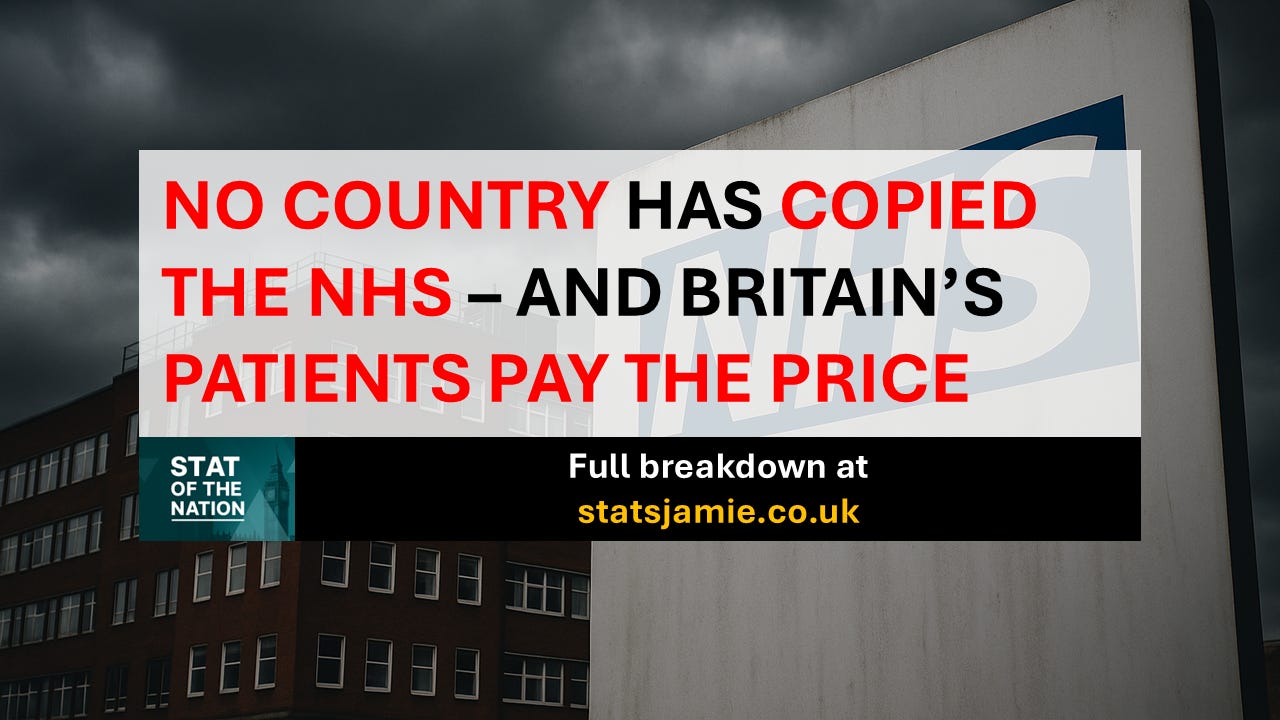No Country Has Copied the NHS – And Britain’s Patients Are Paying the Price
If the NHS was truly world class, others would have copied it. Instead, we face longer waits, an ageing population, and a workforce crisis.
For decades, politicians have told us the NHS is the “envy of the world”. But here’s the truth: no other country has copied the NHS model.
That doesn’t mean we should scrap it. Far from it. The founding principle — healthcare free at the point of use — is one we must protect. But if the NHS is to survive, we need to be honest: the current model is broken, and patients are paying the price.
Labour’s NHS League Tables
This week, Health Secretary Wes Streeting reintroduced NHS “league tables”, ranking every trust in England from best to worst for the first time since the Blair years.
Moorfields Eye Hospital in London came top.
Queen Elizabeth Hospital in King’s Lynn came bottom.
Worst large trust: Mid and South Essex.
Worst community hospital trust: Birmingham Community Healthcare.
Worst ambulance trust: East of England.
Streeting says this will “end the postcode lottery” and drive up standards. Managers at poorly ranked trusts could even see pay docked, while top performers are promised more freedoms.
It makes headlines. But it won’t make waiting lists come down any faster.
The Crisis Patients Face
7.37 million treatments are delayed in England, affecting 6.2 million patients.
More than 190,000 people are waiting over a year, often in pain.
Around 1,000 patients a day spend 12+ hours in A&E.
That’s the crisis. Whether your local trust is ranked 47th or 147th doesn’t change it.
Variation Across the UK
Health is devolved across the four nations of the UK — England, Wales, Scotland, and Northern Ireland. All face the same fundamental problems, and all are failing in similar ways.
Labour has run the NHS in Wales since 1999, with ample time to try a different approach. Instead, on many outcomes, Wales performs even worse than England — longer waiting times, poorer access to treatment, and stretched services.
It shows the problem isn’t just in Westminster. It’s structural, baked into the way the NHS operates across the UK.
The Bigger Picture: A Model Nobody Else Chose
For decades, politicians here have repeated the mantra that the NHS is “the envy of the world”. Yet no other country has copied our model. Not one.
Other advanced nations deliver universal healthcare too — but they’ve chosen systems that blend universal access with competition, insurance, and patient choice. They’ve built models that work better for patients.
That doesn’t mean abandoning the NHS principle. It means protecting it — by being willing to reform a model that clearly isn’t working.
The 75+ Time Bomb
Demand on the NHS rises steeply with age. Older people are far more likely to need regular GP visits, scans, operations, and long-term treatment.
Today: there are 6.5 million people aged 75 and over.
By 2040: that number will hit 9 million — a 37% increase.
If the NHS is struggling today with 6.5 million older patients, what will it look like when that number grows by nearly 40%?
Successive governments have seen these ONS projections for decades — yet hospital beds were cut, medical training capped, and workforce planning ignored. We are staring at a predictable crisis.
The Morality of Overseas Recruitment
There’s another failure hiding in plain sight: workforce planning.
The UK caps the number of medical school places, leaving thousands of qualified young people turned away each year. Then, to plug the gaps, the NHS recruits doctors and nurses from abroad.
This might solve a short-term staffing problem here — but it’s morally wrong. Every country in the world needs healthcare workers to support a healthy nation. When Britain imports staff from poorer countries, we leave those countries weaker and less able to care for their own citizens.
Instead of relying on overseas recruitment, we should be training more of our own young people at home, building a sustainable workforce that can meet the growing demands of an ageing population.
What Needs to Change
Stop the gimmicks — league tables don’t cut waiting times.
Train more staff at home — it’s immoral to cap medical degrees here while poaching doctors from poorer countries.
Face reality — no one has copied the NHS model, and outcomes are worse. Time to learn from abroad and build a system fit for the future.
Conclusion
Patients want care, not gimmicks. They want shorter waits for GPs, faster cancer diagnoses, and timely operations.
League tables don’t deliver that. They make headlines. They shift blame. But they don’t fix a system that no one else in the world has chosen to copy.
If Britain is serious about improving healthcare, we need to stop congratulating ourselves on a failing model and start building one that actually works.
✍️ Thanks for reading Stat of the Nation. If you find these stats and insights useful, please share or subscribe to support my analysis.
I crunch the numbers so you don’t have to.
📲 Follow me here for more daily updates:


